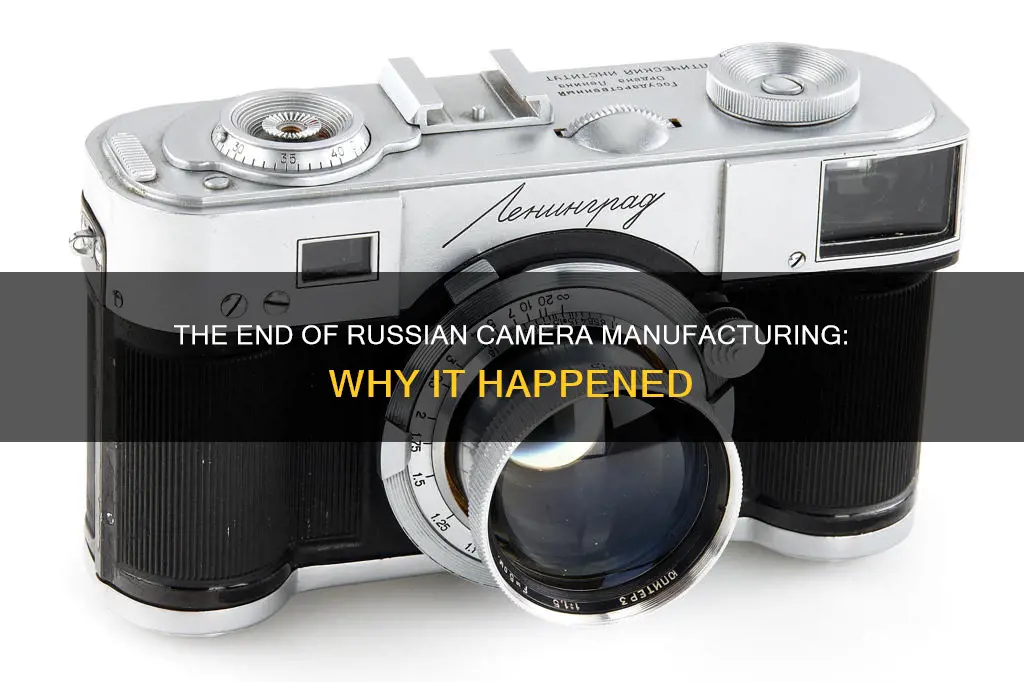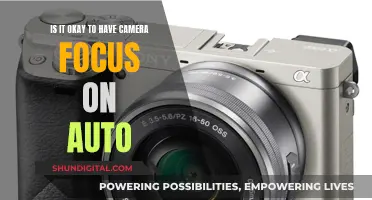
Russian cameras are often overlooked, but they have a rich history and are beloved by analogue photographers for their reliability and affordability. The first Russian camera was produced in 1927, and the industry grew to become the second-largest in the world by the 1970s, with brands like Zenit, Zorki, and Kiev becoming household names. While some Russian cameras were copies of German designs, others showcased innovative features and unique qualities. Today, these vintage cameras are sought after by collectors and enthusiasts, who appreciate their durability, quirky features, and the one-of-a-kind images they produce.
| Characteristics | Values |
|---|---|
| Reason | The market is flooded with high-quality cameras from the last 50 years, and it's hard to compete with the used market. |
| History | The first camera factory in the USSR was originally an orphanage in Kharkov, Ukraine. |
| Design | The Soviet camera industry was dominated by five big names: KMZ, LOMO, Kiev-Arsenal, FED, and MMZ. |
| Quality | The Soviet economy had no incentive to produce quality products. |
| Price | Russian cameras are incredibly affordable. |
What You'll Learn
- The Soviet Union's first camera factory was originally an orphanage
- Soviet cameras were often copies of German designs
- Soviet cameras were cheap to produce and sold at subsidised prices
- Soviet camera factories were told to produce a set number of cameras, and until they were told otherwise, that's what they did
- Soviet cameras are still being used today

The Soviet Union's first camera factory was originally an orphanage
The factory was set up to produce electric drills, but in 1932, the Leica II was released, the first rangefinder with a built-in viewfinder. Soviet leaders were so impressed by the German-made camera that they halted the import of photographic equipment and set the F.E. Dzerzhinsky Factory to work creating their own version.
In 1934, just 18 months after the release of the Leica II, the factory began producing the FED 1, an exact clone of the Leica II. The FED 1 was mass-produced from 1932 until 1941, when German forces destroyed the factory. After it was rebuilt in 1946, the factory continued to make variants of its rangefinders until 1996.
Lightroom and Camera Raw: What's the Difference?
You may want to see also

Soviet cameras were often copies of German designs
The Soviet camera industry was dominated by five big names: KMZ (Krasnogorskiy Mechanicheskiy Zavod) in Moscow, LOMO in St Petersburg, Kiev-Arsenal and FED in Ukraine, and MMZ (the home of BelOMO) in what is now Belarus.
The first Soviet camera was made in 1927, but the industry really took off after World War II. Germany, a camera-making powerhouse, was split into sections, one of which was controlled by Russia. German camera companies were forced to give up their patents and designs. As a result, companies in Russia started producing copies or similar cameras and lenses to the famous German models.
The Fed 1, made in Kharkov, and the Zorki 1, made in Krasnogorsk, Moscow, were good copies of the Leica II. The FED 1 was an exact clone of the Leica II, albeit more crudely constructed. The Zorki 1 was an equally close copy of the Leica II, with only minor discrepancies.
The Leica II was the inspiration for the entire Russian camera industry. However, Soviet cameras were not only copies. The Soviet camera industry also produced many innovative cameras. For example, the Kiev 10, made in the Kiev Arsenal factory, is considered to be a very innovative camera.
The Soviet optical industry is also famous for good optical products, like camera lenses and binoculars. They started by copying German camera lenses but eventually produced their own. For example, the Zeiss Biotar 2/58 became the Helios 44 2/58, and the Leitz Elmar 3,5/50 became the Industar-50 3,5/50.
During the Cold War, the Soviet market was closed to foreign consumer products, so Soviet camera manufacturers in Arsenal Kiev, Fed Kharkov, GOMZ Leningrad, and Krasnogorsk Moscow produced large numbers of cameras for the Soviet market and foreign markets. On international markets, the products were often labelled with local brands like Revueflex, Cosmorex, Kalimar, Spiraflex, Delta, and Prinzflex.
The most common SLR camera in the world is the Zenit, with several variations. The Zenit was initially a copy of the Zorki rangefinder, which was itself a copy of the Leica II. However, later Zenits were not just copies of other SLRs, and many have gone on to be considered relatively iconic.
Charging Camera Batteries: Field Strategies for Photographers
You may want to see also

Soviet cameras were cheap to produce and sold at subsidised prices
The Soviet Union's camera industry was the second-largest in the world, with five big-name manufacturers: KMZ, LOMO, Kiev-Arsenal, FED, and MMZ. They produced a wide range of cameras, from simple compacts to ambitious designs that rivalled the best Western models. The latter were a form of 'soft power', showcasing Soviet ingenuity and engineering prowess.
Soviet cameras were often cheap to produce and sold at subsidised prices, making them attractive to foreign markets as a source of hard currency. The Revue brand in West Germany, for example, included Zenit and FED models. In the US, Zenit SLRs were rebranded by Kalimar, and in Australia, they were known as Global. Soviet cameras were also imported in large numbers to the UK, where they were sold at affordable prices to those on a tight budget.
The Zenit-E, the most-produced 35mm SLR in history, is a prime example of a cheap Soviet camera. With over 12 million units made, it was a frequent sight in the hands of Soviet merchant seamen and workers abroad in the Middle East. Today, it can be purchased online for as little as $10. The Zorki, another popular model, can be found for as little as $30.
The affordability of Soviet cameras, coupled with their unique qualities, has contributed to their enduring appeal among photographers.
The Evolution of Movie Cameras: Where Were They Made?
You may want to see also

Soviet camera factories were told to produce a set number of cameras, and until they were told otherwise, that's what they did
The Soviet Union's camera industry was dominated by five big names: KMZ (Krasnogorskiy Mechanicheskiy Zavod) in Moscow, LOMO in St Petersburg, Kiev-Arsenal and FED in Ukraine, and MMZ (the home of BelOMO) in what is now Belarus.
Soviet factories were given production quotas to meet, and until they were told otherwise, they would continue to produce the same model. This meant that if a camera was found to be unreliable, production would continue regardless.
Yuri Boguslavsky, who runs the Soviet camera shop and repair service Fedka.com in New York, explains that it is important to understand the USSR's different economic system when evaluating Soviet cameras. He says:
> The Soviet economy had no incentive to produce quality products. This is why Soviet cameras and lenses are known for their spotty quality. One can have a super sharp Jupiter-8, and another can get a soft one from the same year, same version, etc. As a former Soviet engineer I want to point out that the designs were generally good. But when the manufacturing started things often went wrong. FED, Arsenal, BelOMO, other factories, had to crank out hundreds of thousands of cameras and lenses, and their quantity, not quality, were the only thing that counted. To meet a quota, factories could substitute brass parts for aluminium, skip calibration steps to speed up assembly – the list goes on.
The F.E. Dzerzhinsky Factory in Kharkov, Ukraine, is a good example of a factory that was given a production target and continued to produce cameras until they were told to stop. The factory was originally an orphanage and was renamed after Felix E. Dzerzhinsky, the founder of the NKVD (a secret police organisation and predecessor of the KGB). In 1932, after the introduction of the Leica II, Soviet leaders stopped the import of photographic equipment and ordered the factory to create their own version. Just 18 months later, in 1934, the factory began producing its first clone of the Leica II rangefinder camera. The factory continued to produce millions of cameras until it closed in 2008.
The Krasnogorsky Mekhanichesky Zavod KMZ (Mechanical Factory of Krasnogorsk), near Moscow, is another example of a factory that mass-produced cameras. They are known for producing the Iskra, Kristall, Mir, Moskva, Start, Zenith (early series), and Zorki series.
The quality of Soviet cameras varied depending on the factory and the time period. Cameras produced in the 1950s and 1960s, when production standards were reputed to be at their highest, are considered to be better than those made in the 1980s.
Camera Raw CC: Is It Free to Use?
You may want to see also

Soviet cameras are still being used today
Many Soviet cameras are also available on the secondhand market, with some photographers favouring older models over newer ones. Some of the most popular Soviet cameras include the Zenit, Zorki, Moskva, Kiev, FED, Smena, Chaika, Sport, and Lubitel.
The affordability of Soviet cameras is a large part of their appeal. A Leica from the 1960s might cost $600, whereas a Zorki or FED from the same period might cost $60. Soviet lenses are also much cheaper than their modern counterparts, and can be used with digital SLRs via an adapter.
While some Soviet cameras are prized for their reliability, others are known for their poor quality and manufacturing defects. The quality of Soviet cameras can vary depending on the period in which they were manufactured, with construction and quality control standards declining in the 1970s and 1980s.
Despite their mixed reputation, Soviet cameras remain popular among analogue enthusiasts for their unique results and quirky qualities.
Lightroom Won't Recognize Camera Raw Files: Here's Why
You may want to see also
Frequently asked questions
The short answer is that the Soviet Union no longer exists, and the countries that made up the USSR now have access to Western camera brands.
Some popular Russian camera brands included Zenit, Zorki, Moskva, Horizon, Kiev, FED, Smena, Chaika, Sport, and Lomo.
Russian camera manufacturers made a wide variety of cameras, including Leica copy rangefinders, Contax-style rangefinders, SLRs, simple viewfinder cameras, TLRs, and medium format SLRs.
Russian cameras have a reputation for being of lower quality than their Western counterparts, due to spotty quality control and a lack of incentive to produce high-quality products. However, some Russian cameras are well-loved by photographers for their quirky qualities, relative affordability, and unique results.







